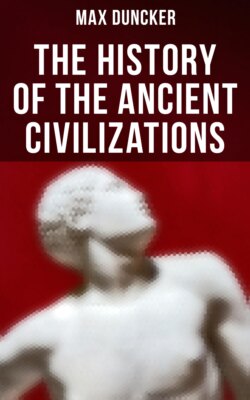Читать книгу The History of the Ancient Civilizations - Duncker Max - Страница 52
На сайте Литреса книга снята с продажи.
FOOTNOTES:
Оглавление[27] Diod. 2, 21; Euseb. "Chron." 1, p. 56; 2, p. 11, ed. Schöne; Syncellus, "Chron." 1, 313, 314, ed. Bonn; Brandis, "Rer. Assyr. tempor. emend." p. 13 seq.
[28] Euseb. "Chron." 1, p. 26, ed. Schöne.
[29] 1, 184, 187.
[30] Vol. i. 512.
[31] Ménant, "Annal." p. 18.
[32] G. Smith, "Discov." p. 249.
[33] The date of Tiglath Adar is fixed by the statement of Sennacherib that he lost his seal to the Babylonians 600 years before Sennacherib took Babylon, i.e. about the year 1300 B.C. As the series of seven kings who reigned before Tiglath Adar is fixed, Assur-bil-nisi, the first of these, can be placed about 1460 B.C. if we allow 20 years to each.
[34] Vol. i. p. 262.
[35] This series, Pudiel, Bel-nirar and Bin-nirar, is established by tiles of Kileh-Shergat, and the fact that it joins on to Assur-u-ballit, by the tablet of Bin-nirar discovered by G. Smith, in which he calls himself great grandson of Assur-u-ballit, grandson of Bel-nirar, and son of Pudiel; G. Smith, "Discov." p. 244.
[36] G. Smith, "Discov." pp. 244, 245.
[37] E. Schrader, "Keilinschriften und A. T." s. 20; "Records of the Past," 7, 17.
[38] Ménant, "Annal." p. 73.
[39] G. Smith, loc. cit. p. 249.
[40] G. Smith, loc. cit. p. 250; E. Schrader, "A. B. Keilinschriften," s. 294. As Sennacherib states that he brought back this seal from Babylon after 600 years, and as Sennacherib took Babylon twice in 704 and 694 B.C., the loss of it falls either in the year 1304 or 1294 B.C. As he brings back the Assyrian images of the gods at the second capture (694 B.C.), the seal of Tiglath Adar may have been brought back on this occasion.
[41] G. Smith, loc. cit. p. 250.
[42] So the passage runs according to a communication from E. Schrader. On the reading Adarpalbitkur as against the readings Ninpalazira and Adarpalassar, see E. Schrader, "A. B. Keilinschriften," s. 152. On what Ménant ("Annal." p. 29) grounds the assumption that Belkudurussur was the immediate successor of Tiglath Adar I cannot say; it would not be chronologically impossible, but the synchronistic tablet merely informs us that Adarpalbitkur was the successor of Belkudurussur; G. Rawlinson, "Mon." 2, 49. Still less am I able to find any foundation for the statement that Binpaliddin of Babylon, the opponent of Belkudurussur and Adarpalbitkur, was a vassal-king set up by Assyria. The date of Tiglath Pilesar I. is fixed by the Bavian inscription, which tells us that Sennacherib at his second capture of Babylon brought back out of that city the images of the gods lost by Tiglath Pilesar 418 years previously (Bav. 43–50), at the period between 1130 and 1100 B.C. If he began to reign 1130, then the five kings before him (the series from Adarpalbitkur to Tiglath Pilesar is fixed by the cylinder of the latter), allowing 20 years to each reign, bring us to 1230 B.C. for the beginning of Belkudurussur. To go back further seems the more doubtful, as Tiglath Pilesar put Assur-dayan, the third prince of this series, only 60 years before his own time.
[43] Sayce, "Records of the Past," 3, 31; Ménant, loc. cit. p. 31.
[44] Communication from E. Schrader.
[45] Cf. G. Smith, loc. cit. p. 251.
[46] Vol. i. p. 263; Ménant, loc. cit. p. 32.
[47] Ménant, "Annal." pp. 47, 48.
[48] Column, 1, 62, seqq., 1, 89.
[49] Column, 5, 44.
[50] Column, 6, 39.
[51] Ménant, loc. cit. p. 48.
[52] Vol. i. p. 519; E. Schrader, "Keilinschriften und A. T." s. 16.
[53] Ménant, loc. cit. p. 51.
[54] Vol. i. p. 263; Bavian Inscrip. 48–50; Ménant, "Annal." pp. 52, 236. Inscription on the black basalt-stone in Oppert et Ménant, "Documents juridiques," p. 98. Is the name of the witness (col. 2, 27), Sar-babil-assur-issu (p. 115), correctly explained by "The king of Babel has conquered Asshur"?
[55] Col. 1, 62.
[56] Ammian. Marcell. 18, 9.
[57] Araziki cannot be taken for Aradus, the name of which city on the obelisk and in the inscriptions of Assurnasirpal, Shalmanesar, and elsewhere is Arvadu.
[58] Sayce, "Records," 3, 33; Ménant, "Annal." p. 53; "Babylone," pp. 129, 130.
[59] According to G. Smith ("Discov." p. 91, 252) this Samsi-Bin II. restored the temple of Istar at Nineveh which Samsi-Bin I. had built (above, p. 3).
[60] Inscription of Kurkh, "Records of the Past," 3, 93; Ménant, "Annal." p. 55.
[61] Ménant, "Annal." p. 63.
[62] E. Schrader, "Keilinschriften und A. T." s. 7.
